Grain Boundary Evolution of Cold-Rolled FePd Alloy during Recrystallization at Disordering Temperature
Abstract
:1. Introduction
2. Experimental Setup
3. Results and Discussion
3.1. Determination of Recrystallization Behavior
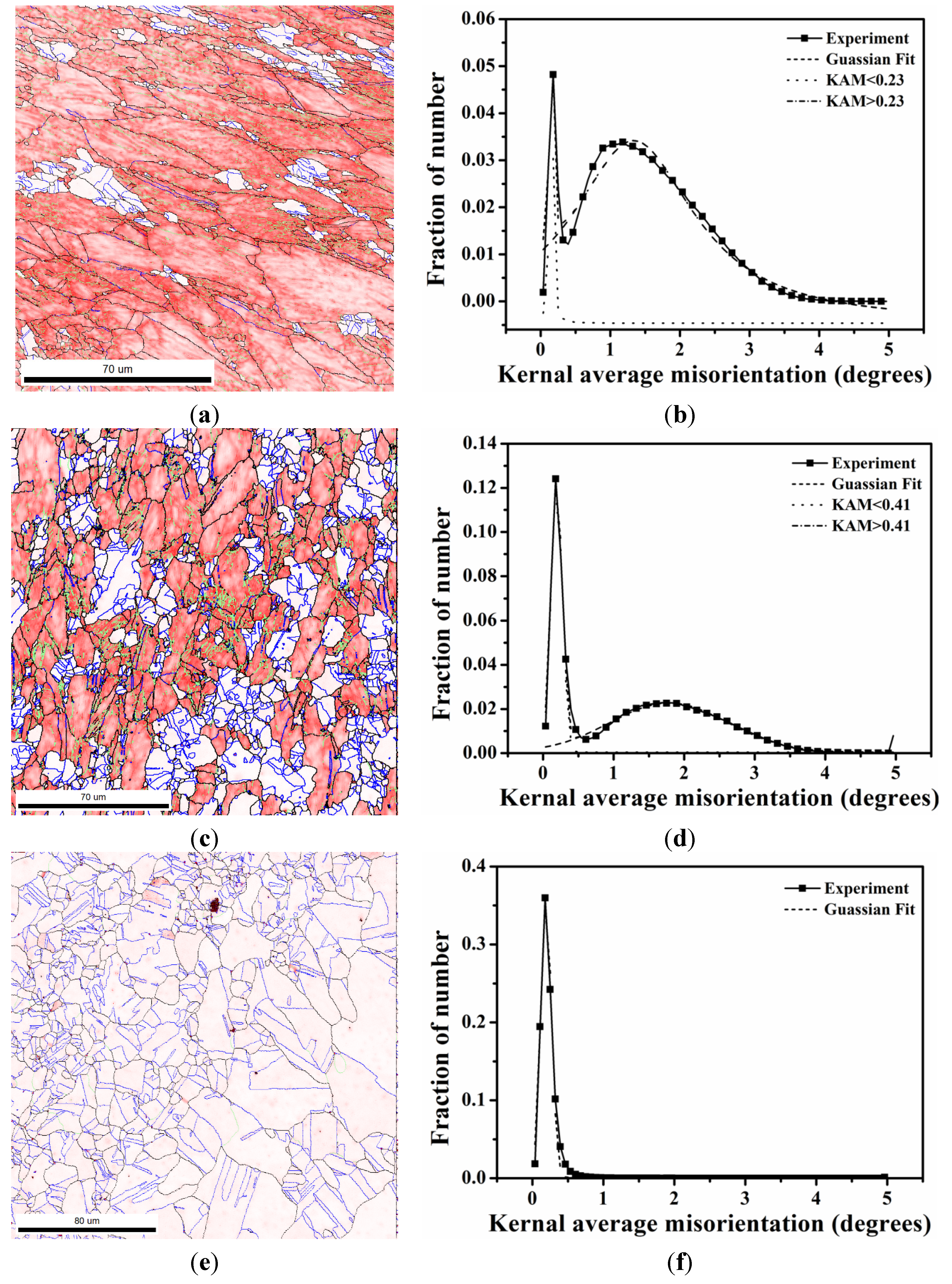
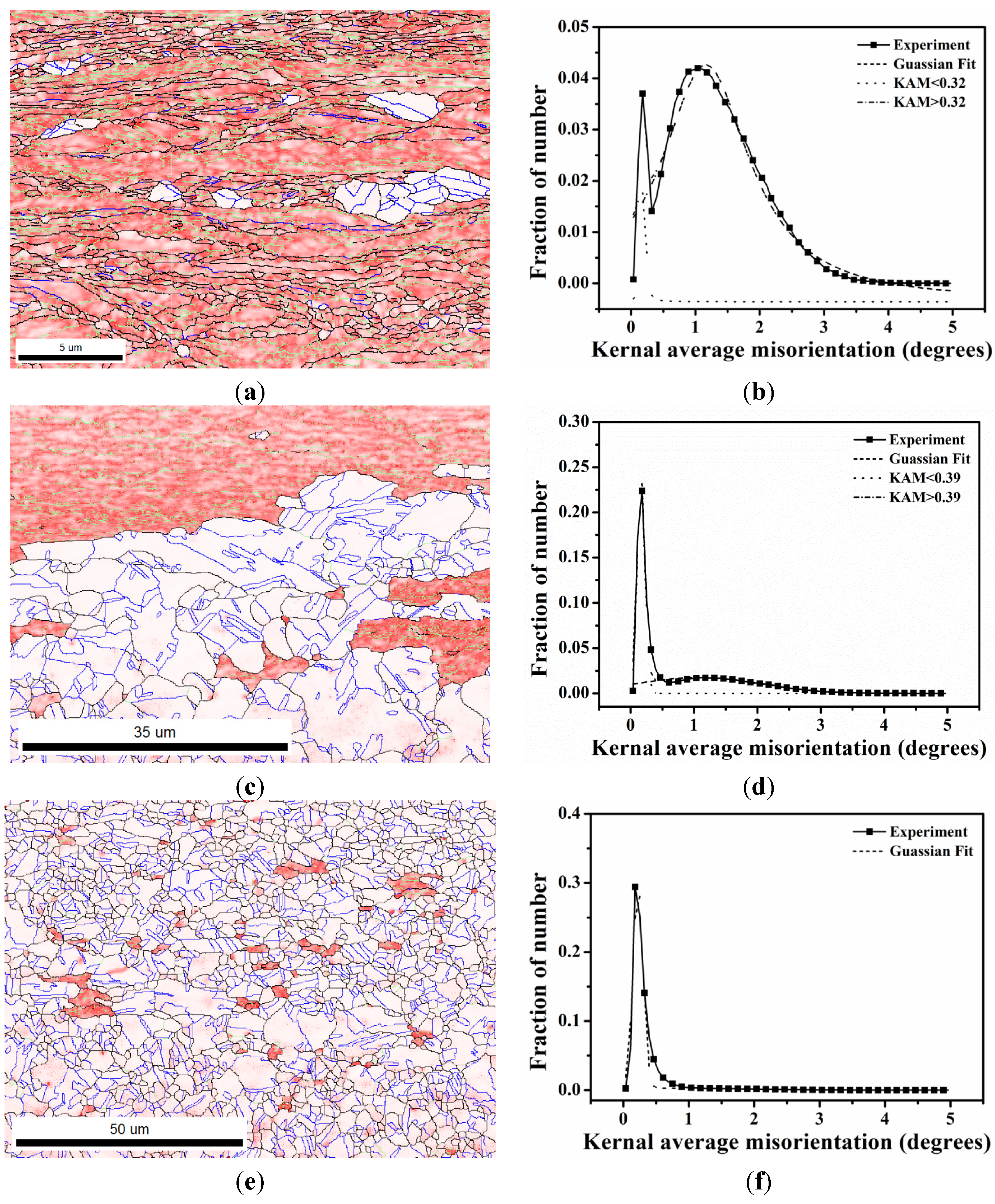
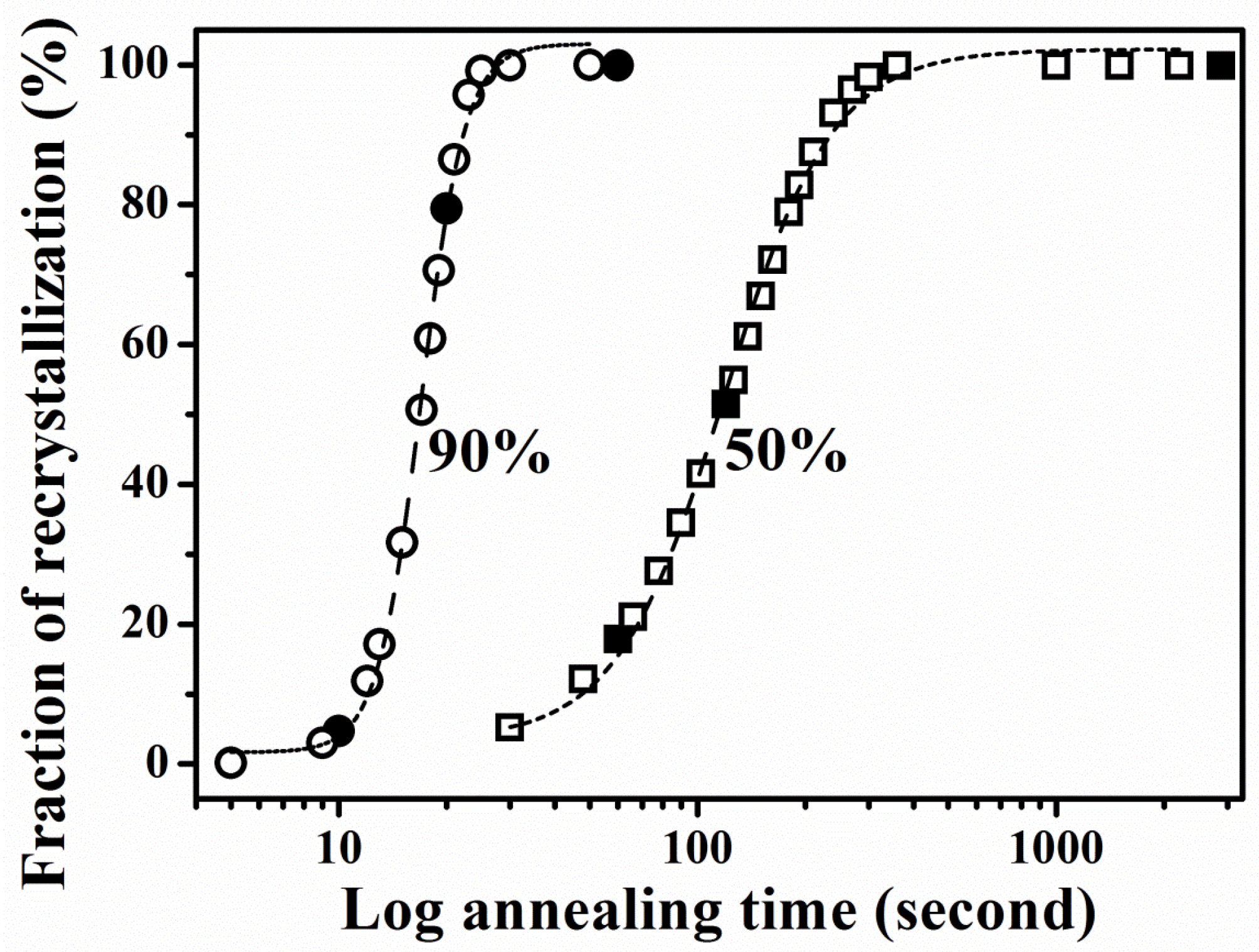
| Annealing Time (h) | 0.5 | 1 | 4 | 16 | 96 | 400 |
|---|---|---|---|---|---|---|
| 50% cold rolling | - | 0% | - | 33% | 67% | 100% |
| 90% cold rolling | 10% | 26% | 67% | 100% | - | - |
3.2. Effect of Grain Boundaries on Recrystallization


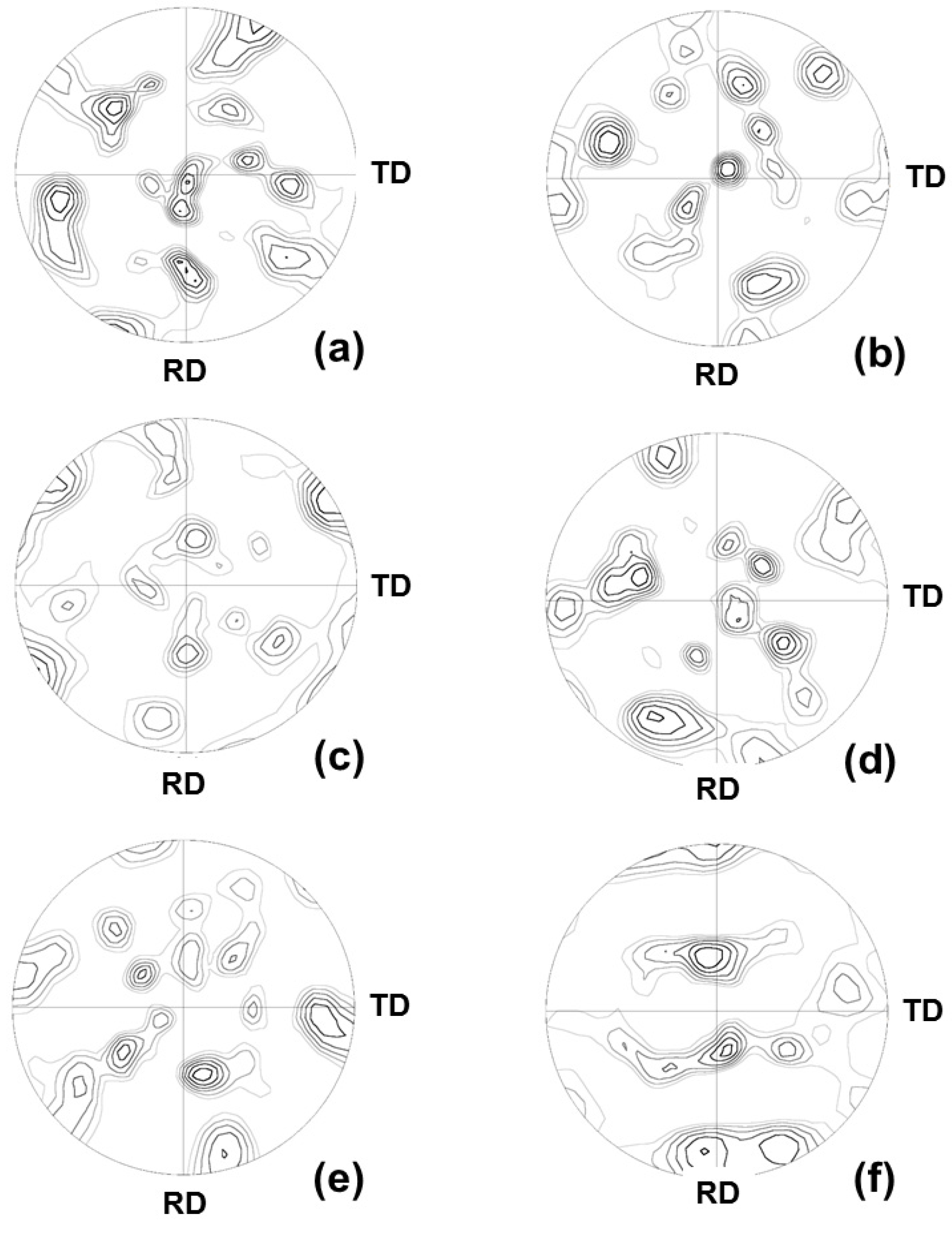
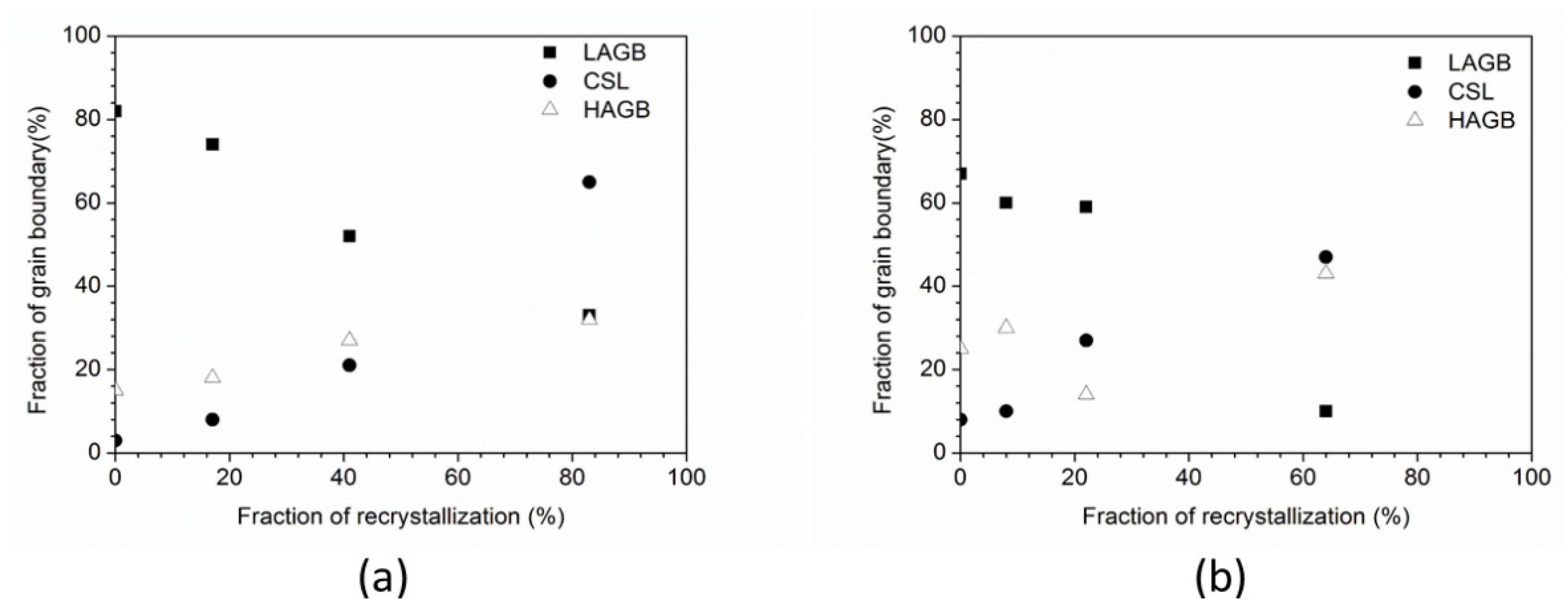
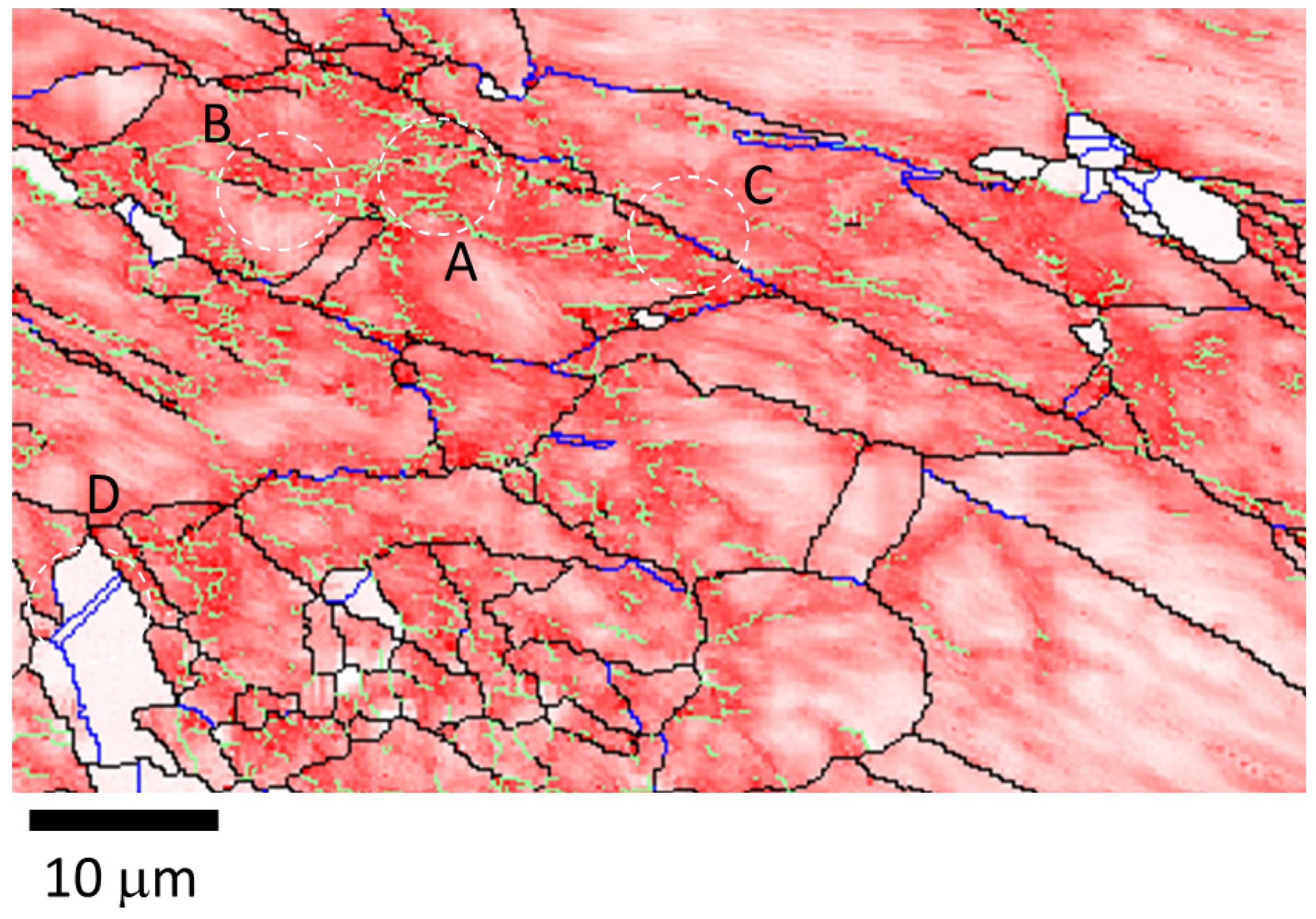
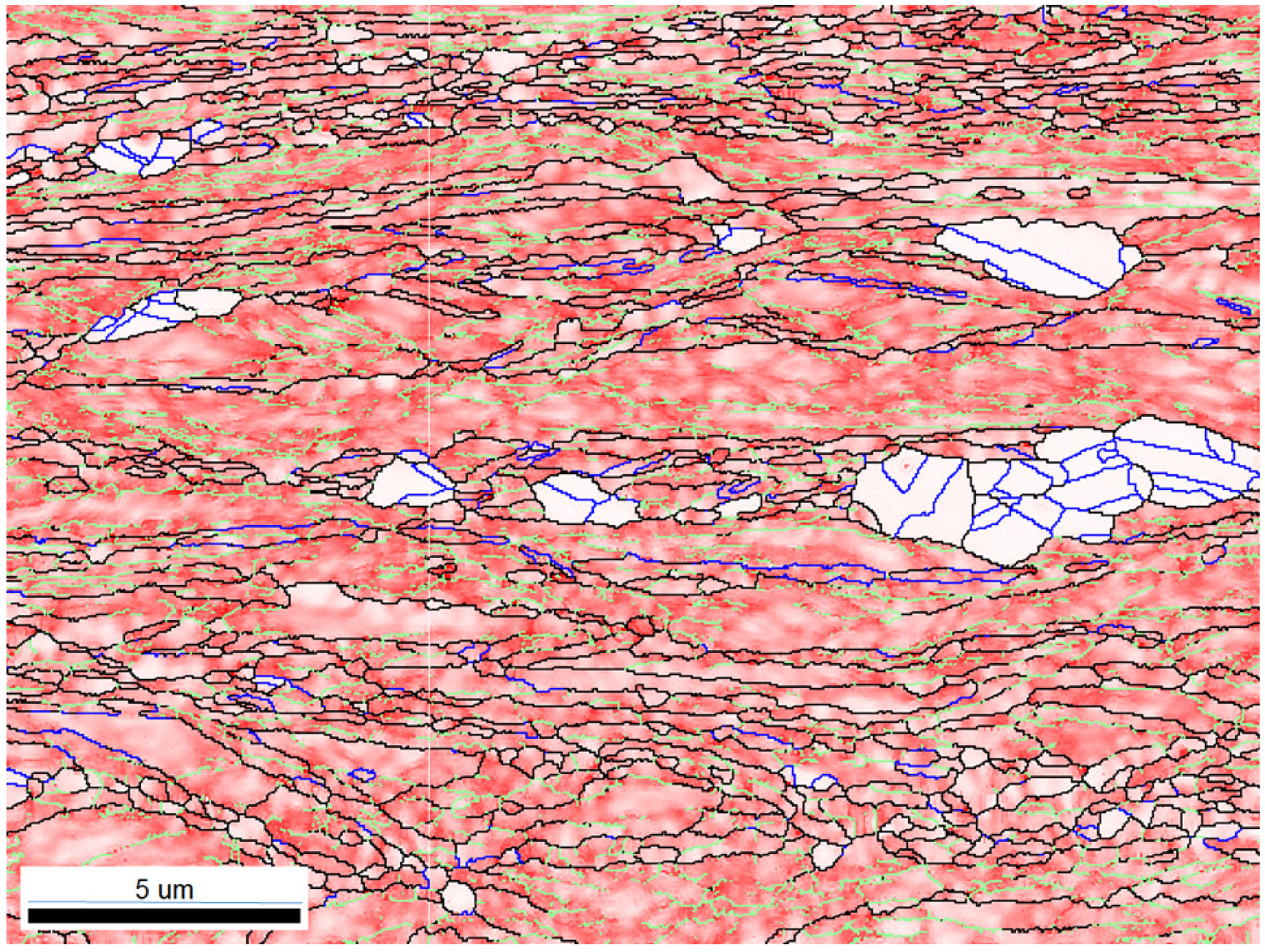
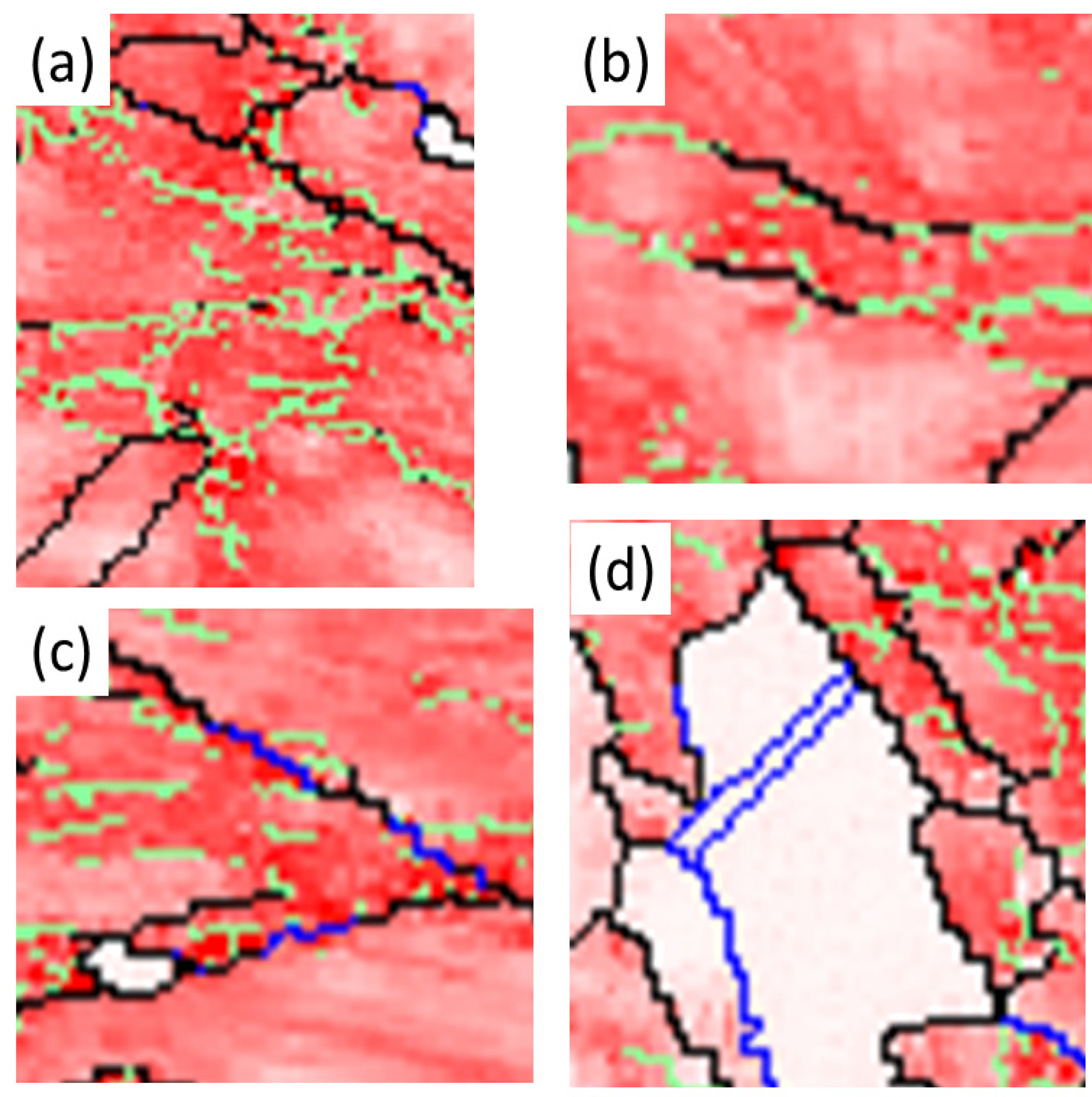
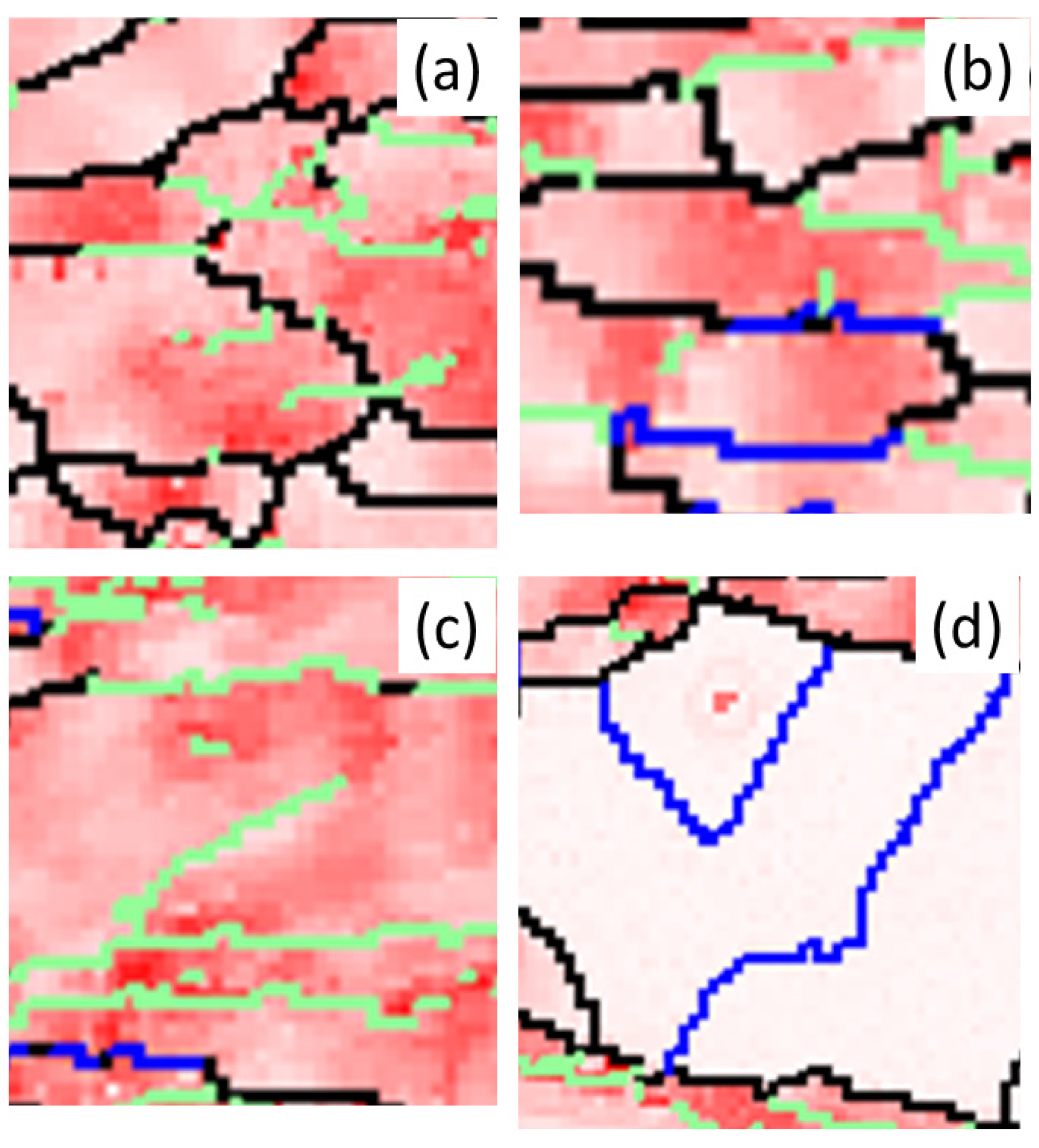
4. Conclusions
Acknowledgments
Author Contributions
Conflicts of Interest
References
- Yamaguchi, M.; Umakoshi, Y. The deformation behaviour of intermetallic superlattice compounds. Prog. Mater. Sci. 1990, 34, 1–148. [Google Scholar] [CrossRef]
- Weller, D.; Moser, A. Thermal effect limits in ultrahigh density magnetic recording. IEEE Trans. Magn. 1999, 35, 4423–4439. [Google Scholar] [CrossRef]
- Klemmer, T.; Hoydick, D.; Okumura, H.; Zhang, B.; Soffa, W.A. Magnetic hardening and coercivity mechanisms in L10 ordered FePd ferromagnets. Scr. Metall. Mater. 1995, 33, 1793–1805. [Google Scholar] [CrossRef]
- Fingers, R.T.; Rubertus, C.S. Application of high temperature magnetic materials. IEEE Trans. Magn. 2000, 36, 3373–3375. [Google Scholar] [CrossRef]
- Sundar, R.S.; Deevi, S.C. Soft magnetic FeCo alloys: Alloy development, processing, and properties. Int. Mater. Rev. 2005, 50, 157–192. [Google Scholar] [CrossRef]
- Wang, L.; Fan, Z.; Roy, A.G.; Laughlin, D.E. Effect of atomic ordering on the Curie temperature of FePd L10 type alloys. J. Appl. Phys. 2004, 95, 7483–7485. [Google Scholar] [CrossRef]
- Smallman, R.E.; Green, D. The dependence of rolling texture on stacking fault energy. Acta Metall. 1964, 12, 145–154. [Google Scholar] [CrossRef]
- Smith, T.G. Proceedings of the ICOTOM5: Texture of Materials; Gottstein, G., Luecke, K., Eds.; Springer Verlag: Berlin, Germany, 1978; Volume 2, p. 485.
- Yushkov, V.I.; Adamescu, R.A.; Machnev, Y.S.; Gapeka, T.M.; Geld, P.V. The developments in texture in stainless steel. Mater. Sci. Eng. 1984, 64, 157–169. [Google Scholar] [CrossRef]
- Donadille, C.; Valle, R.; Dervin, P.; Penelle, R. Development of texture and microstructure during cold-rolling and annealing of F.C.C. alloys: Example of an austenitic stainless steel. Acta Metall. 1989, 37, 1547–1571. [Google Scholar] [CrossRef]
- Dickson, M.J.; Green, D. The cold-rolling and primary-recrystallisation textures of 18% chromium steels containing 10%, 12% and 14% Nickel. Mater. Sci. Eng. 1969, 4, 304–312. [Google Scholar] [CrossRef]
- Randle, V. Simulation of mesotexture between deformed and recrystallised microstructures. Mater. Sci. Technol. 1990, 6, 1231–1235. [Google Scholar] [CrossRef]
- Chowdhury, S.G.; Datta, S.; Kumara, B.R.; De, P.K.; Ghosh, R.N. Randomization of texture during recrystallization of austenite in a cold rolled metastable austenitic stainless steel. Mater. Sci. Eng. A 2007, 443, 114–119. [Google Scholar] [CrossRef]
- Lin, H.P.; Chen, Y.C.; Chen, D.; Kuo, J.C. Effect of cold deformation on the recrystallization behavior of FePd alloy at the ordering temperature using electron backscatter diffraction. Mater. Charact. 2014, 94, 138–148. [Google Scholar] [CrossRef]
- Hu, H. Texture of metals. Texture 1974, 1, 233–258. [Google Scholar] [CrossRef]
- Raabe, D. Texture and microstructure evolution during cold rolling of a strip cast and of a hot rolled austenitic stainless steel. Acta Mater. 1997, 45, 1137–1151. [Google Scholar] [CrossRef]
- Virnich, K.H.; Koehlhoff, G.D.; Luecke, K.; Pospiech, J. Proceedings of the ICOTOM5: Texture of Materials; Gottstein, G., Luecke, K., Eds.; Springer Verlag: Berlin, Germany, 1998; Volume 1.
- Humphreys, F.J. Modelling mechanisms and microstructures of recrystallization. Mater. Sci. Technol. 1992, 8, 135–144. [Google Scholar] [CrossRef]
- Eichelkraut, H.; Hirsch, J.; Luecke, K. Rolling and Recrystallization Textures in Copper-Germanium Alloys. Z. Metallkd. 1984, 75, 113–123. [Google Scholar]
- Washburn, J.; Parker, E.R. Kinking in zinc single-crystal tension specimens. J. Metals 1952, 4, 1076–1078. [Google Scholar]
- Li, C.H.; Edwards, E.H.; Washburn, J.; Parker, E.R. Stress-induced movement of crystal boundaries. Acta Metall. 1953, 1, 223–229. [Google Scholar] [CrossRef]
- Winning, M.; Gottstein, G.; Shvindlerman, L.S. Stress induced grain boundary motion. Acta Mater. 2001, 49, 211–219. [Google Scholar] [CrossRef]
- Winning, M. Motion of <100>-tilt grain boundaries. Acta Mater. 2003, 51, 6465–6475. [Google Scholar] [CrossRef]
- Heinrich, M.; Haider, F. Primary recrystallization in slightly tensile deformed aluminium single crystals. Philos. Mag. 1996, 74, 1047–1057. [Google Scholar] [CrossRef]
- Luecke, K. Proceedings of the ICOTOM7: Proceedings Texture of Materials; Brakman, C.M., Jongenburger, P., Mittemiejer, E.J., Eds.; Netherlands Society of Materials Science: Noordwijkerhout, The Netherlands, 1984.
- Lin, H.P.; Ng, T.S.; Kuo, J.C.; Chen, Y.C.; Chen, C.L.; Ding, S.X. EBSD Study on Crystallographic Texture and Microstructure Development of Cold-Rolled FePd Alloy. Mater. Charact. 2014, 93, 167–172. [Google Scholar] [CrossRef]
- Kolmogorov, A.N. A statistical theory for the recrystallization of metals. Izv. Akad. Nauk SSSR Ser. Matem. 1937, 1, 355–359. [Google Scholar]
- Johnson, W.A.; Mehl, R.F. Reaction kinetics in processes of nucleation and growth. Trans. AIME 1939, 135, 396–415. [Google Scholar]
- Avrami, M. Kinetics of phase change. I general theory. J. Chem. Phys. 1939, 7, 1103–1112. [Google Scholar] [CrossRef]
- Avrami, M. Kinetics of phase change. II: Transformation-time relations for random distribution of nuclei. J. Chem. Phys. 1940, 8, 212–224. [Google Scholar] [CrossRef]
- Avrami, M. Granulation, phase change, and microstructure kinetics of phase change. III. J. Chem. Phys. 1941, 9, 177–184. [Google Scholar] [CrossRef]
- Humphreys, F.J.; Hatherly, M. Recrystallization and Related Annealing Phenomena, 2nd ed.; Elservier: New York, NY, USA, 2004. [Google Scholar]
- Cahn, J.W. Transformation kinetics during continuous cooling. Acta Metall. 1956, 4, 572–575. [Google Scholar] [CrossRef]
- Mandal, S.; Bhaduri, A.K.; Sarma, V.S. Influence of state of stress on dynamic recrystallization in a titanium-modified austenitic stainless steel. Metall. Mater. Trans. A 2012, 43, 410–414. [Google Scholar] [CrossRef]
- Mao, W.; Zhu, G.; Yu, Y. Influence of order-disorder transition on the recrystallization behaviors of a cold rolled FeCo alloy. Z. Metallkd 2000, 91, 211–214. [Google Scholar]
- Winning, M.; Raabe, D. Applications of Texture Analysis: Ceramic Transactions; Rollett, A.D., Ed.; The American Ceramic Society: Hoboken, NJ, USA, 2009; Volume 201. [Google Scholar]
© 2015 by the authors; licensee MDPI, Basel, Switzerland. This article is an open access article distributed under the terms and conditions of the Creative Commons Attribution license (http://creativecommons.org/licenses/by/4.0/).
Share and Cite
Lin, H.-P.; Chen, D.; Kuo, J.-C. Grain Boundary Evolution of Cold-Rolled FePd Alloy during Recrystallization at Disordering Temperature. Materials 2015, 8, 3254-3267. https://doi.org/10.3390/ma8063254
Lin H-P, Chen D, Kuo J-C. Grain Boundary Evolution of Cold-Rolled FePd Alloy during Recrystallization at Disordering Temperature. Materials. 2015; 8(6):3254-3267. https://doi.org/10.3390/ma8063254
Chicago/Turabian StyleLin, Hung-Pin, Delphic Chen, and Jui-Chao Kuo. 2015. "Grain Boundary Evolution of Cold-Rolled FePd Alloy during Recrystallization at Disordering Temperature" Materials 8, no. 6: 3254-3267. https://doi.org/10.3390/ma8063254





